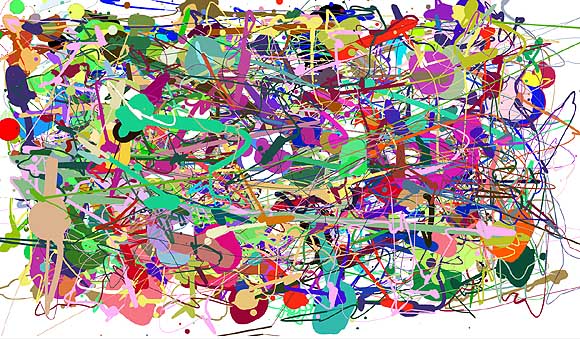View current page
...more recent posts

Above is an image I created using a Flash "make your own Jackson Pollock" program created by Miltos Manetas. He didn't design the software, completely--the code is from a downloadable web toy called "splatter" that he appropriated, customized to allow the application of multiple colors, and renamed "jacksonpollock.org." The idea is you can make drippy "Pollocks" by moving your mouse around.
This is a screen shot from another make-your-own Pollock utility, currently on view at vertexList, by C.J. Yeh. Instead of cursor sweeps, you play notes on a keyboard, and Yeh's software translates the tune into Pollockesque colors and drip spacings. These "Pollocks" are more naturalistic than the output from Manetas' repurposed splatter device, reproducing canvas weave texture and avoiding the obnoxious secondary colors.
Pollock is a perennial target for computer geeks. Besides these DIY-Pollock programs (the former insider-ironically smartass, the latter insider-sincerely "deconstructive"), we were recently subjected to a barrage of hype about the computer science prof who could purportedly identify fake Pollocks by measuring drip sizes, fling rates, and so forth. And a few years before that, critic Pepe Karmel used computer analysis of Hans Namuth's studio photos of Pollocks-in-progress* to determine that beneath the convoluted abstraction lay images of the human figure, which Pollock "always drew first."
At the core of this all this computation--cheeky, earnest, or pseudoscientific--lies the assumption, essentially, that Pollock is stupid, and that his art, far from being the "difficult" thing art mavens have built careers defending, is really rather simple. See, you can do one. He's just another "brand." His dripping was so predictable that a machine can recognize it and simulate it. When you get past all the art-crit theory positing the work as "industrial," "oceanic," and "decentralizing," it turns out that deep down Pollock just loved people. In theory circles this is known as "recuperation." You'd have thought it would have happened already with Pollock, but apparently it's still ongoing. Is it possible that computer nerds (including computer nerd artists) are 40 years behind interior decorators? Or--gasp--that there's something about Pollock that's still getting under people's skin?
*see, e.g., Francis V. O'Connor, Ph.D., writing about Karmel's analyis of Number 27, 1950:
Pollock began the work, as Karmel documents, at the bottom left corner of the narrow end of the long canvas, in the area just above where the present signature is, with a drawing in black paint of a large-headed, childlike, striding, humanoid figure. He then filled in the rest of the canvas with other humanoid and animal figures until he had an overall structure of line-drawings on the blank canvas. He used these forms to create a web of hubs radiating black lines, and then covered them with the colors and forms now visible on the surface, with a few of the black lines visible around the edges. It is these black forms around the periphery of the painting that now "work" when the painting is viewed as a vertical composition -- which it was to begin with. I suspect that Pollock thought of the whole enterprise in respect to the little figure with which he began it -- and that determined the greater coherence of the vertical composition. Since he also had a tendency to want to obscure recognizable images with which he probably identified (see Supplement to the JPCR, p. 79), he may have signed it near the figure to accomplish this. Whatever the unknowable inner motivations, the painting self-evidently works best as a vertical, and it ought to be hung that way at the Whitney from now on, along with Namuth's photo proving the precedent.
In fairness to geeks, the Karmel analysis only used a computer technician as a hired gun. The "search for the figure" beneath the paintings' actual stated (surface) premises had more to do with critical conservatism than geeky reduction. If Pollock had drawn an engorged penis before covering it up with abstract patterns, would that have made the work sexual? The point is, he covered it up. The "research" was spurious and ultimately soothing to bourgeois anxieties about art with "no subject." It's mentioned in this post because the computer--which Karmel & Co. used to rectify canvases seen at odd angles in the photographs, the better to perceive those hidden stick men--gave the enterprise a patina of scientific rationality.
Updated after I learned the Manetas piece was a goof on a designer's work--I didn't know the source, but do wish we could get past "canonical artist" jokes.
Updated again Sept. 30 with minor edits and a more Pollocklike Pollock from jacksonpollock.org.
